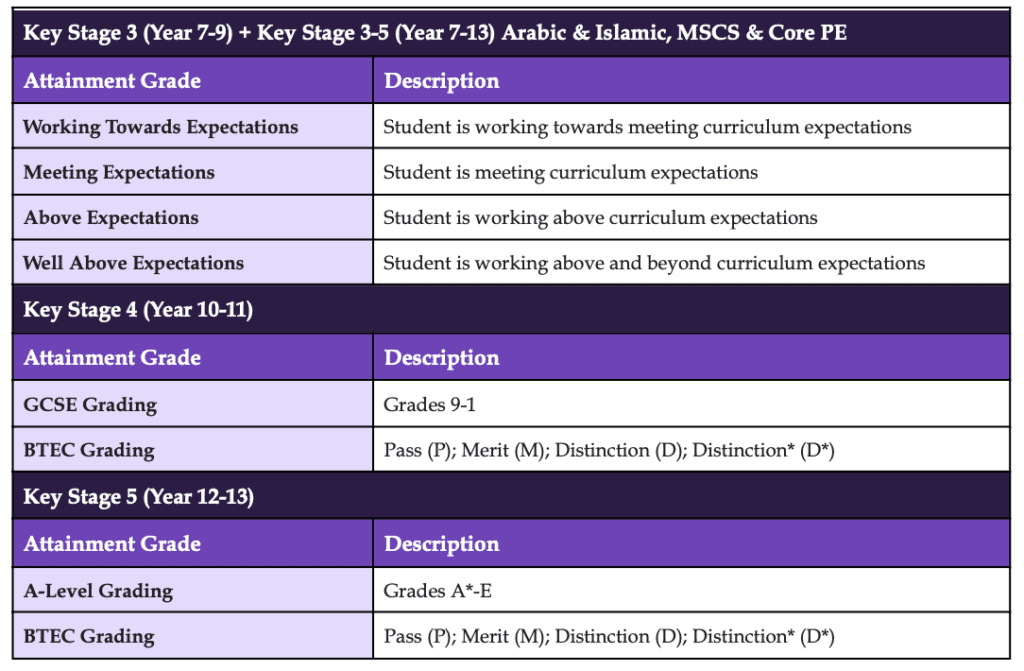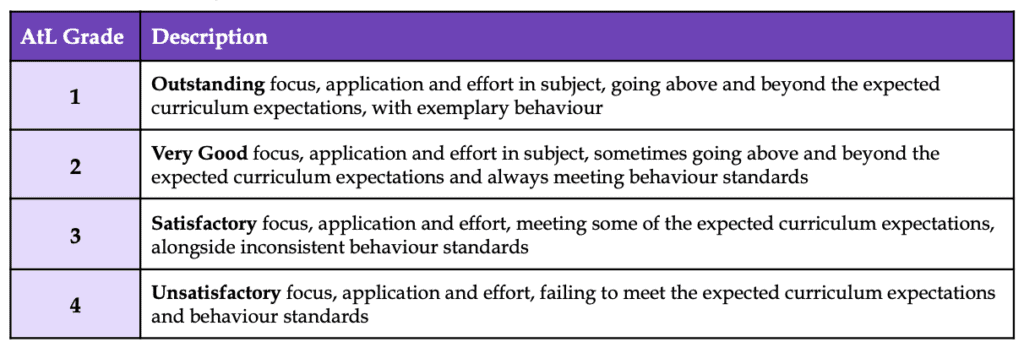- Home
- About Us
- Admission
- Learning
- School Life
- Parent Essentials
- Contact Us
Secondary
To help you understand your child’s report card, please refer to the explanations below, which provide guidance on the key terminology used on student report cards, alongside how each piece of information has been formulated.
Students receive a Minimum Expected Target Grade at the beginning of each year in Key Stage 3 (KS3), a GCSE Target Grade at the start of Key Stage 4 and an A-Level Target Grade at the start of Key Stage 5 (KS5)*. These targets take into consideration a number of indicators, including GL CAT4 (Cognitive Abilities Test), prior academic performance and subject teachers’ professional judgement. It is important to state that target grades merely act as a guide and students may well exceed them across the academic year.
*Please note that targets may be adjusted at Key Stage 5 based upon AS Examination results in Year 12
Attainment is based upon a student’s outcome at a specific point in time – this is measured against subject curriculums, assessment criteria or grade descriptors. Table 1.1 provides an overview of the attainment grades that are given at each Key Stage (KS3-5) in the Secondary phase.

The attainment grade given in each reporting cycle (Assessment Point 1-3) is based upon a range of student work that has been taken into account by subject teachers in order to provide a reflective and holistic grade. The evidence considered at each reporting cycle will be a cumulative outcome from the start of the academic year to the given reporting point. e.g. the grade given in the Term 2 reporting cycle will consider a range of evidence from the start of the academic year up until the point of reporting in Term 2.
Each department will have agreed pieces of evidence to support and inform the attainment grade for Term 1, Term 2 and Term 3. The number of pieces of evidence used by each department to inform their grading will vary based on the amount of contact time they have with students. Assessments will not be conducted simply for reporting purposes and the attainment grade on student reports will not be the result of a single piece of assessed work. Teachers’ professional judgement will be used to holistically assign an attainment grade in line with the curriculum expectations (KS3) or GCSE/A-Level specifications (KS4-5) for each subject.
It is also important to state that student performance is not a linear process; it is absolutely normal to see grades fluctuate at each reporting cycle, based on the range of content taught and the application of knowledge and skills across the curriculum. Should grades change significantly, the school will make contact with parents to ensure the necessary support is provided to students to get them back on track.
The Progress Indicator (PI) is an assessment of how students are performing at each reporting cycle in relation to their Target Grade (TG). Table 1.2 provides a summary of the progress grading system.

Students receive an Attitude to Learning Grade from 1-4 for each subject. This grade is an indication of their current level of focus, application, effort and behaviour in lessons, in line with each subject’s curriculum expectations and school’s behavioural expectations. Students receive a ‘Settling In AtL’ in the first half-term, focused on how they have started the new academic year, and an ‘AtL’ at each Assessment Point. Table 1.3 provides a description of each of the AtL grades.

Safa Community School – Al Barsha South | All Rights Reserved © 2022